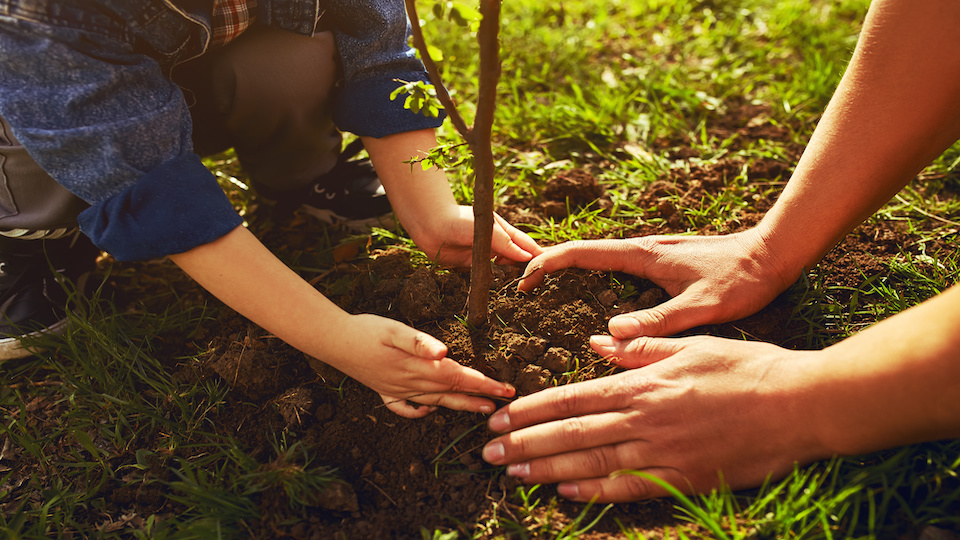You are ready, shovel in hand and your tree beside you. If you have already read our tree shopping guide, you are indeed ready to plant. Here are a few basic guidelines that will contribute to the long-term health and growth of your tree.
How deep is your hole?
Many people have the mistaken belief that planting the sapling in a deep hole will give the tree more stability. It has been found to be one of the leading causes of early mortality of transplanted trees. The hole should be only as deep as the height of the root ball so that the tree remains at the same level as it currently is. The point at which the roots start from the trunk should be just below the soil surface. The bottom of the root ball should sit on flat ground with undisturbed soil. If the soil is loose underneath, the plant will sink deeper into the hole with the settling of the soil.
The hole should be quite wide, though, preferably three times the width of the root ball. This allows better horizontal root run which stabilizes the plant. Of late, loosening the soil up to five times the width of the root ball as well as backfilling the hole with the same soil is recommended.
Watering newly planted trees
Trees should be watered immediately after planting to allow the soil to settle down around the roots. This also eliminates air pockets. Newly planted trees will require daily watering for the next 4-6 weeks. Constant moisture in the root zone promotes the development of new roots. Water stress should be avoided at this time.
After six weeks, you can gradually decrease watering frequency to once in 2-3 days, but water deeply every time. The extra water will percolate into the deeper layers of the soil, and the plant roots will be encouraged to grow deep. But if the plant shows any signs of wilting, continue to water daily for some more time.
Even after the tree is established, water should be provided once a week for the first 2-3 years. Water deeply, at a wider circle, around the planting hole rather than right at the base of the tree. If a drip irrigation system is being set up, place several emitters for each tree or place a coil of soaker hose around 1 ½ -2 ft from the base.
Provide support and protection
Young trees transplanted into the landscape need protection against wind, extreme temperatures, and marauding animals. Staking may be necessary to prevent the tree from swaying too much in the wind, tearing up new roots. Frequent root damage taxes the tree and delays its proper establishment in the new site. It may take up to two years for the tree to have a sturdy trunk and root system to withstand wind rock.
Staking is the most common technique to stabilize newly planted trees. The stakes should be sturdy, but not more than one-third of the tree’s height. This allows the root to remain stable while the top portion of the trunk gets to sway in the wind, which helps toughen it. When using a single stake, it should be driven 2ft into the ground on the windward side of the tree and tied loosely with a figure of eight.
A hardware mesh cylinder around the tree buried 3-inches in the ground and extending to 4-5 ft above ground should protect it from rodent and deer damage. Burlap screens may be used for winter protection.
Mulch generously
Mulching around trees has many benefits. A thick layer of mulch protects the soil, preventing it from drying out. It acts like a blanket, regulating soil temperature and preventing wide fluctuations. Mulches suppress weeds that would otherwise compete with the tree roots. They give a neat look to the landscape. Organic mulches slowly disintegrate, adding nutrients to the soil. You can make your own mulch by shredding the leaves collected in the yard, but readily available hardwood mulches like shredded pine bark are long-lasting.
With all the benefits mulching offers, it can backfire if not done properly. Mulch should ideally cover at least 3ft off the ground all around the tree, but shouldn’t be more than 3-inches deep. The idea is to protect the soil, not choke it. Avoid piling the mulch against the tree trunk; it can initiate bark rot, offering a convenient point of entry to many pests and pathogens.
Know when to feed
Fertilizers should not be used in the backfill soil at the time of planting the sapling; instead of boosting growth, they can cause fertilizer shock. Even amending the soil with compost should be done only if it is very poor or clayey. If the sapling is planted in areas where turf grass grew earlier, the soil may already have a sufficient amount of nutrients. Otherwise, slow-release organic fertilizers such as Osmocote can be mixed in the loose soil 1-2 ft away from the root ball. The nutrients will become available to the plant once it starts growing actively, spreading out its roots. If soil testing shows a deficiency of nitrogen or potassium, a quick release fertilizer may be broadcast well away from the root ball area and watered in.
Young trees grow rapidly for the first few years, so their nitrogen requirement can be quite high. Urea can meet this need, but if you want to stick to organic gardening, use animal-based organic fertilizers that have higher nitrogen content. Application of a dose of standard fertilizer in spring is beneficial to all trees.
-Susan Patterson



